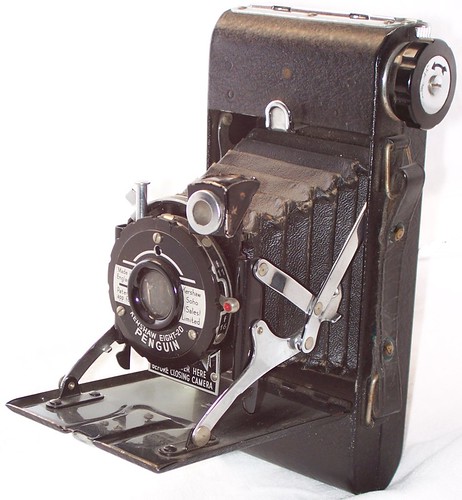Difference between revisions of "Kershaw Eight-20 Penguin"
m |
|||
| Line 1: | Line 1: | ||
{{Flickr_image | {{Flickr_image | ||
| − | |image_source= http:// | + | |image_source= http://www.flickr.com/photos/89864432@N00/428402199/in/pool-camerapedia/ |
|image= http://farm1.static.flickr.com/177/428402199_7ea0416bd2.jpg | |image= http://farm1.static.flickr.com/177/428402199_7ea0416bd2.jpg | ||
|image_align= right | |image_align= right | ||
Revision as of 23:59, 23 March 2007

|
The Kershaw Eight-20 Penguin is one of the simpler models of Kershaw-Soho's camera series for type 120 roll film. It is a vertical folding camera. When the bellows is unfolded its front plate is in a fixed position - no moves possible. But despite of the camera's simple quality it offers a distance selector with a range from 6 feet to infinity. The distance lever moves the lens/shutter-unit forward or backward, and moves also a pointer on the opposite side of the lens tube. A marker is printed onto the lower front side, as well as an explaining hint that says: "Set pointer here before closing camera". That means that the pointer points onto the marker when the distance lever is moved to infinity position. That's when the lens/shutter-unit is closest to the front plate. Then the door can be shut without problems. The plastic ring around the lens front plate is the speed selector, allowing the choice between the only shutter speed an B mode. The aperture choice is as poor, offering only f11 and f16. The aperture lever with the red point moves a second, smaller aperture into or out of the optics. The shutter release has a long shifting travel on which the shutter is cocked before its release. The much too little brilliant viewfinder is turnable (ca. 90 degrees) to make it usable for vertical and horizontal exposures. Maybe he robust metal body with metal door has preserved many of these cameras which were introduced in 1951. Further features are the easily removable camera back, the bakelite film winding knob, a stilt foldable from the camera door, and of course a red exposure counting window in the camera back.